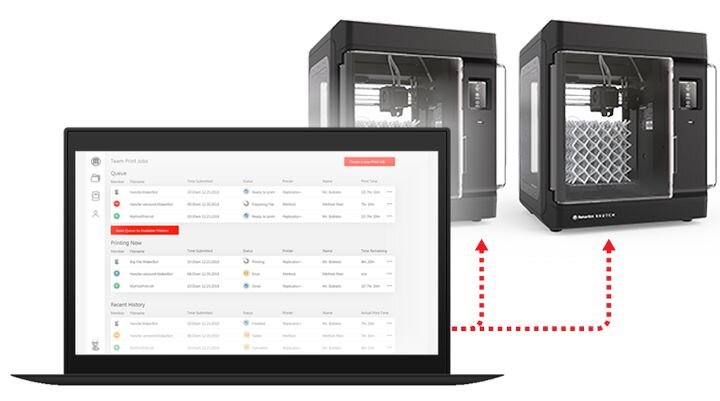![MakerBot’s cloud ecosystem for the new MakerBot Classroom product [Source: MakerBot]](https://fabbaloo.com/wp-content/uploads/2020/05/image-asset_img_5eb08b77ec6ab.jpg)
After today’s surprise announcement of the new MakerBot Classroom package, I am reflecting on what this means for the market.
If you haven’t read our story on MakerBot Classroom, I encourage you to do so. The TLDR version is that they’ve designed a 3D printing ecosystem in a box that directly meets the workflow needs of teachers and students in a classroom. The solution, which includes a sophisticated cloud system, materials and TWO 3D printers costs only US$1,799.
Educational 3D Printer Benefits
This could be the best solution for many schools who seek a 3D printing solution. 3D printing is an incredibly good technology for schools, as it can be used to demonstrate so many topics, including:
-
Design to manufacturing flow
-
Purposeful design
-
Design thinking
-
3D modeling
-
Prototyping and iteration
-
Problem solving
-
And more
Early Educational 3D Printers
Early attempts to address the education market occurred when many nascent 3D printer manufacturers unexpectedly discovered there was not going to be a massive general consumer market for them. They rapidly pivoted their business operations to focus on the education market because it was one where they would have fewer (if any) changes to make to their equipment design.
Many companies simply collected a set of lesson plans and marketed that to schools as a package. At first, this might have been attractive, because other options at the time were simply a general desktop 3D printer, with no instructions on what to do with it for students. In many cases the machines were idle because teachers didn’t know what to do, let alone do it optimally. Lesson plans helped somewhat.
But as a product development strategy, stapling some lesson plans to a product that’s design for general, not educational use, is probably not the best way forward.
It seems that MakerBot has taken a huge step up in this market by not only redesigning the 3D printer itself, but more importantly redesigning the entire workflow around the use of the 3D printer.
MakerBot Focus Group
I suspect MakerBot had a slight advantage over other players in the educational 3D printer market because they already have a significant install base of around 7,000 schools. This is partly due to their early notoriety in the space thanks to their early entry in 2009 and subsequent extensive media coverage.
But that install base allowed them to dig deeper into the workings of how schools actually used the machines. MakerBot apparently has a kind of “advisory group” of educational practitioners who use their machines with whom they meet frequently. From this group they were able to learn a more extensive view of what really goes on in the classroom.
Purposeful 3D Printer Design
It seems that they took all this knowledge and redesigned everything from the ground up, taking some elements from their experience with other machines. The result is their new MakerBot Classroom product.
It is a product specifically designed for this market and no other; marketing the MakerBot SKETCH to professionals would make no sense. Marketing the MakerBot SKETCH to DIY 3D printer folks would also make no sense, although I am sure some might criticize the machine simply because it comes from MakerBot. The important thing for them to know is that this machine is definitely not for them; it’s for educators.
That is the most important thing to learn here: we have a desktop 3D printer (and associated ecosystem) that is specifically designed for a particular use case. It is unlike virtually any other 3D printer offering, where general-purpose 3D printers were refocused on the education market.
For other 3D printer manufacturers pursuing the education market, the new MakerBot Classroom product sets a very high standard to match, and I would not be surprised if some begin to fade away as time passes.
Via MakerBot


"It seems that they took all this knowledge and redesigned everything from the ground up, taking some elements from their experience with other machines."
That’s completely false, Sketch is a well known Chinese 3D printer from Flashforge, they simply rebrand it.
"It seems that they took all this knowledge and redesigned everything from the ground up, taking some elements from their experience with other machines."
That’s completely false, Sketch is a well known Chinese 3D printer from Flashforge, they simply rebrand it.